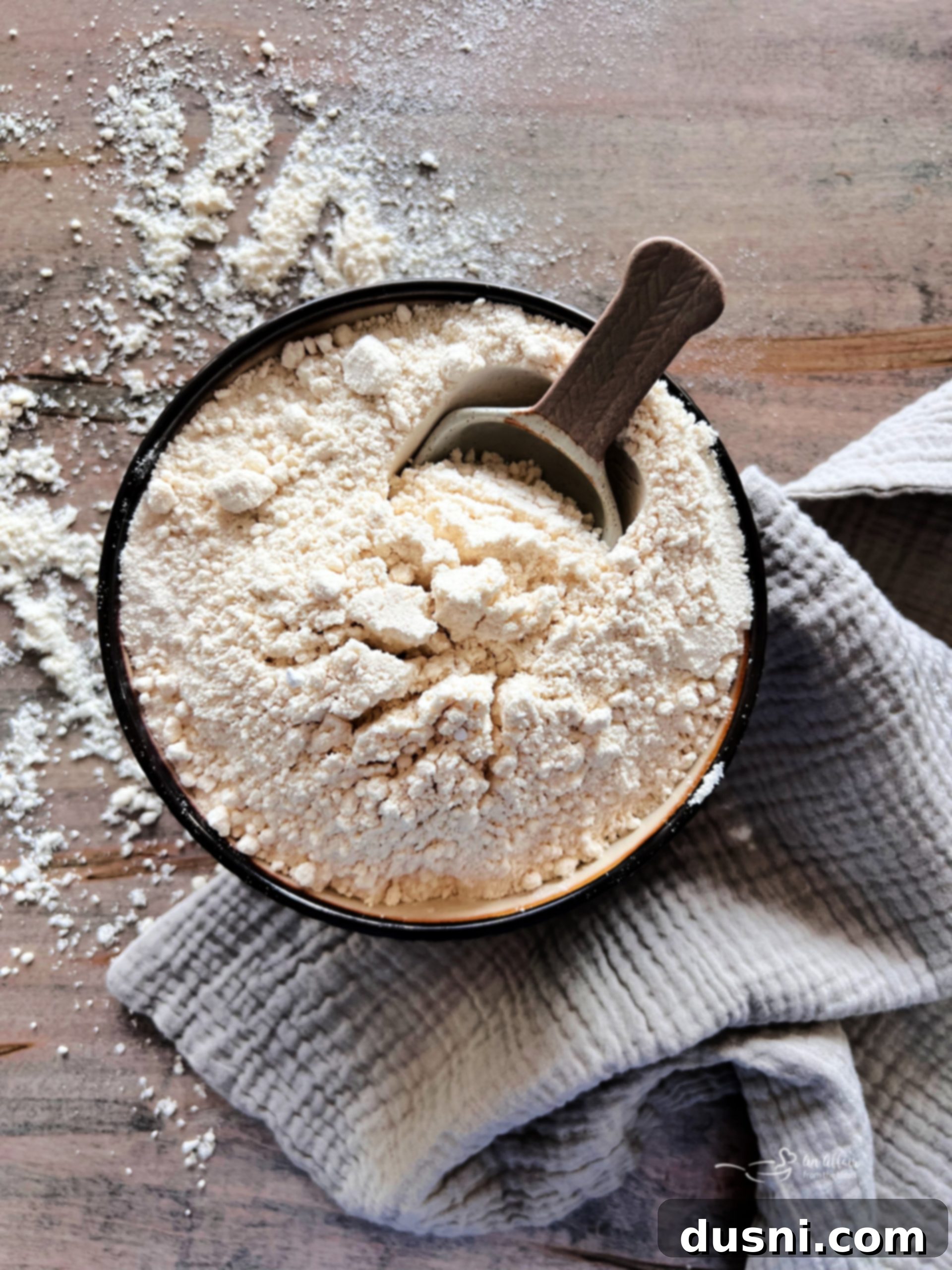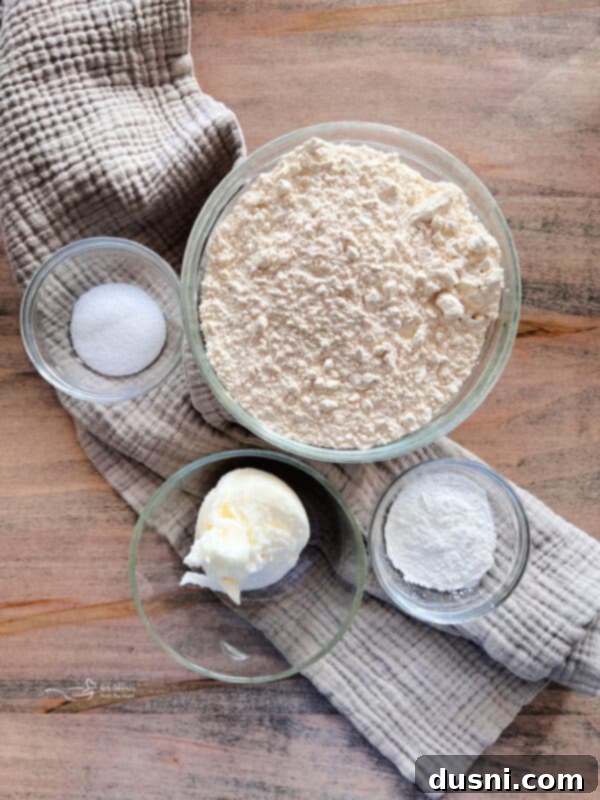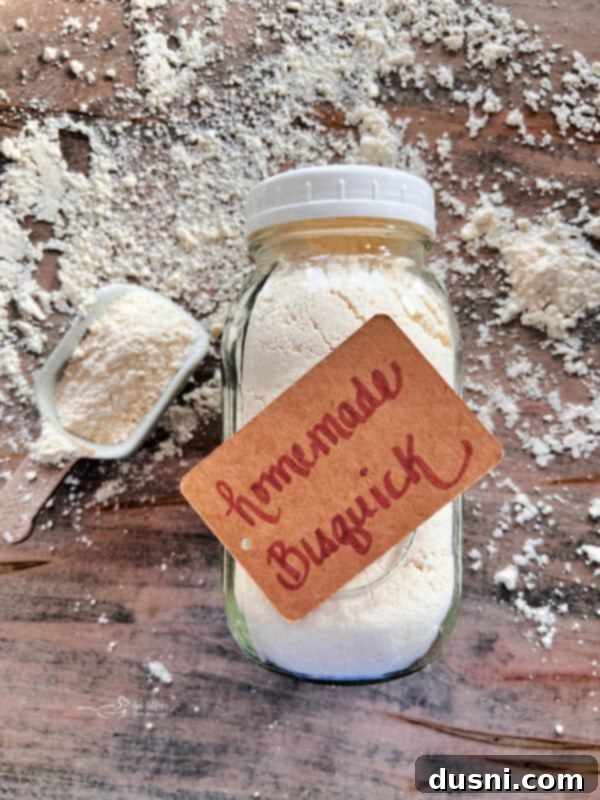Homemade Bisquick Mix: Your Ultimate Guide to a Versatile Pantry Staple
Have you ever found yourself in the middle of a recipe, craving fluffy pancakes or tender biscuits, only to realize your box of Bisquick baking mix is almost empty? The disappointment is real, but don’t let it send you on an unexpected trip to the grocery store. With just a few common pantry ingredients and this simple guide, you can whip up your very own **Homemade Bisquick Mix** in minutes! It’s an effortless, economical, and incredibly rewarding way to ensure you’re always ready for your next baking adventure.
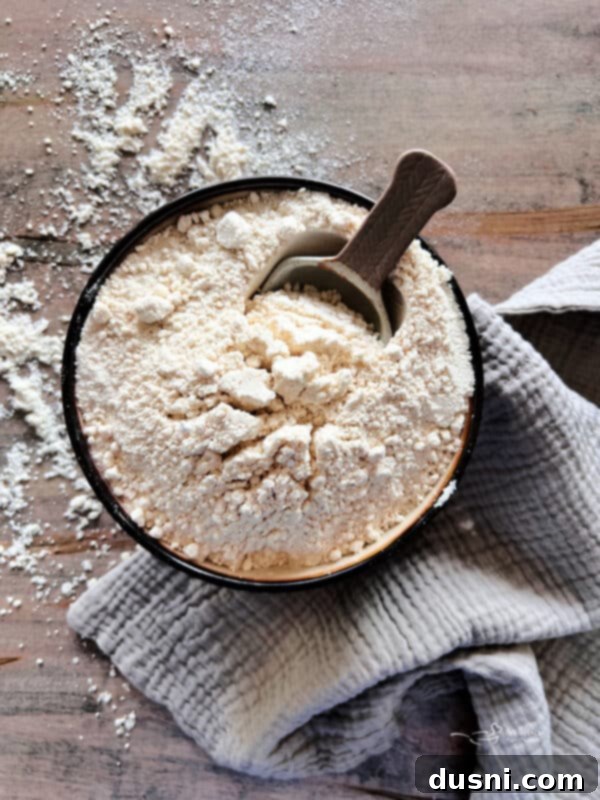
Preparing your own baking mix from scratch is not only surprisingly easy but also incredibly satisfying. Once you discover how simple it is, you’ll wonder why you didn’t start making this DIY Bisquick substitute sooner!
Why Make Your Own Bisquick Mix? Convenience, Savings, and Control!
While store-bought Bisquick is undeniably convenient, making your homemade version offers a multitude of benefits. Beyond avoiding that emergency grocery run, you gain control over the ingredients, often at a fraction of the cost. This easy Bisquick substitute allows you to customize your mix to dietary needs or preferences, such as using whole wheat flour for added fiber or opting for specific fats. Imagine the satisfaction of knowing exactly what goes into your family’s favorite treats, free from hydrogenated oils or artificial additives. It’s a smart, sensible, and economical choice for any home baker.
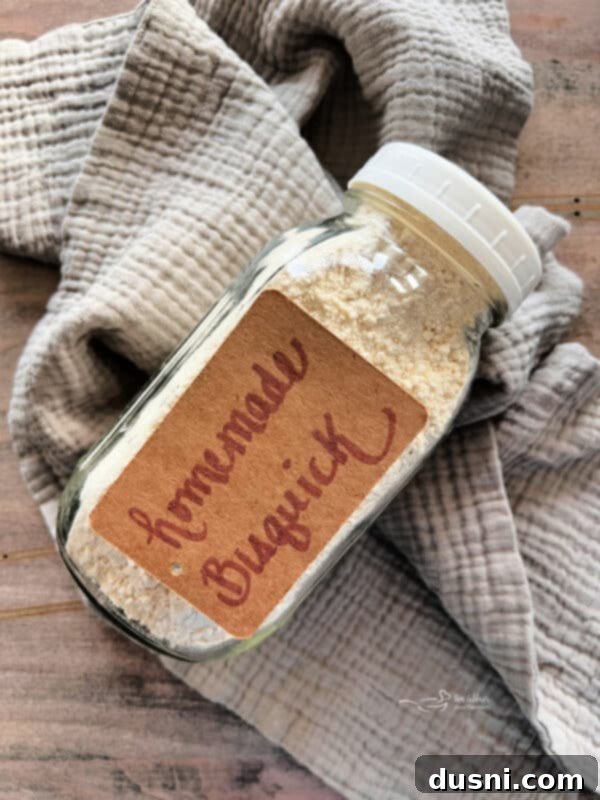
The Fascinating Origin Story of Bisquick
Bisquick, a household name synonymous with quick and easy baking, has a rich history dating back to the 1930s. The story goes that a visionary executive from General Mills (Betty Crocker’s parent company) was on a train when he encountered the bar car’s chef. This chef revealed his secret to consistently fresh biscuits: a pre-mixed batter he prepared ahead of time, containing flour, baking powder, salt, and lard. This simple revelation sparked a brilliant idea that transformed home baking forever.
The concept of a ready-to-use baking mix, pre-combining the dry ingredients and a stable fat, was revolutionary. It eliminated multiple measuring steps and streamlined the baking process for busy homemakers. The “lightbulb moment” on that train journey ultimately led to the creation of Bisquick, a mega-million-dollar product that has remained a pantry staple for generations, simplifying everything from breakfast pancakes to savory dinners.
Understanding Bisquick: What’s Inside and Why Homemade is Great
What makes Bisquick so incredibly versatile and convenient? It’s the clever combination of pre-mixed dry ingredients, specifically flour, a leavening agent, and fat. The original commercial Bisquick mix utilizes hydrogenated oil for its fat component, which contributes to its long shelf life and powdery texture. However, when you make your own homemade Bisquick mix, you have the flexibility to choose your fat. While hydrogenated oils are used in the commercial version, this recipe typically calls for vegetable shortening, a popular and stable alternative. You can also experiment with lard, cold butter, or even coconut oil, each offering slightly different flavor profiles and textures.
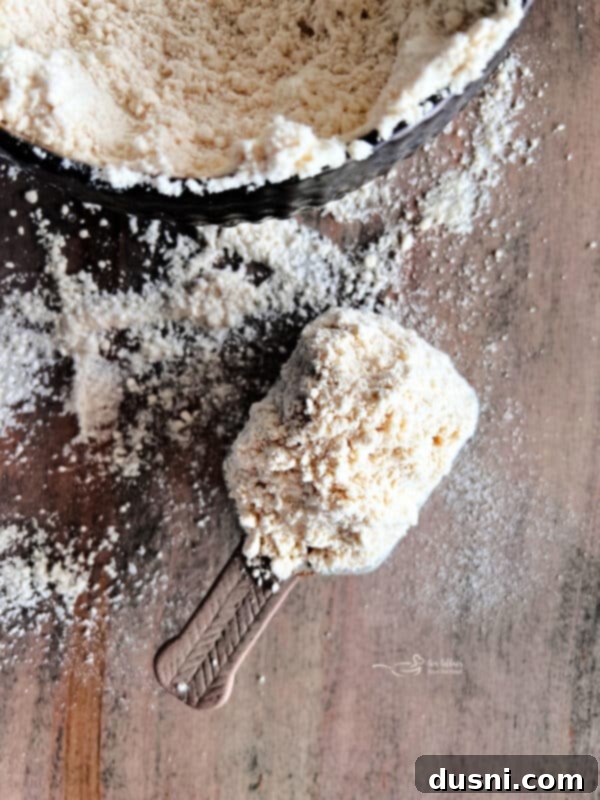
One of the most appealing aspects of making your own Bisquick substitute is the ability to create healthier versions. By incorporating part whole wheat flour, spelt flour, or even gluten-free flour, you can cater to specific dietary needs. You can also choose lighter oils like canola, sunflower, or safflower for a different fat profile, though these will affect storage. This DIY approach empowers you to enjoy your favorite baked goods with ingredients you trust.
Essential Ingredients for Your Homemade Bisquick Mix
Ready to craft your own versatile baking mix? You’ll be delighted by how few ingredients are required. The complete measurements and detailed instructions can be found in the printable recipe card at the bottom of this post, but here’s a quick overview of what you’ll need and why each component is crucial:
Flour
The foundation of your mix! All-purpose flour is the standard choice, providing a neutral base that works well for a variety of recipes. However, feel free to experiment with a combination of flours. Adding spelt flour or whole wheat flour can increase the nutritional value and impart a subtle nutty flavor. For a gluten-free Bisquick alternative, use your favorite gluten-free all-purpose blend.
Baking Powder
This is your primary leavening agent, responsible for the light and fluffy texture of your biscuits, pancakes, and other baked goods. Ensure your baking powder is fresh for optimal rise. If it’s old, your baked goods might come out dense. A simple test: mix a spoonful in warm water; if it fizzes, it’s good to go!
Vegetable Shortening (or Alternatives)
Shortening is key to creating a stable, long-lasting dry mix. It provides the necessary fat that makes baked goods tender and flaky. While vegetable shortening is preferred for its neutral flavor and excellent shelf life, you have alternatives. Lard can be used for a more traditional flavor, or coconut oil for a plant-based option. If using cold unsalted butter, make sure it’s very cold and cut into small pieces to blend well, and note that it will affect storage duration.
Salt
Just a touch of salt is all you need to enhance the overall flavor profile of your baked goods. It balances the sweetness in desserts and elevates the savory notes in dishes like biscuits.
Step-by-Step Guide: How To Make Your Own Bisquick Mix
Creating your own Bisquick substitute is incredibly straightforward. Follow these simple steps to ensure a perfectly blended mix ready for all your baking needs.
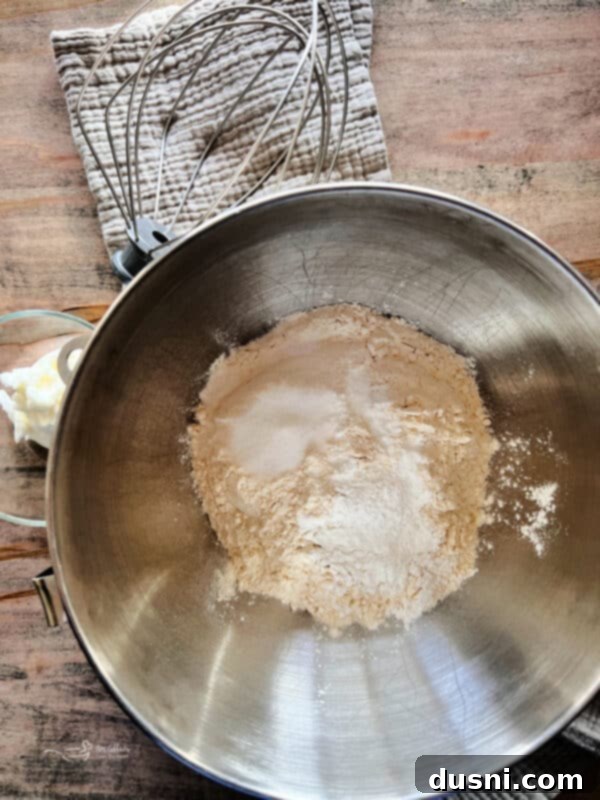
Step 1: Combine Dry Ingredients
In the bowl of your standing mixer, fitted with the whisk attachment, combine the flour, baking powder, and salt. Whisk these ingredients together thoroughly until they are uniformly mixed. This ensures that the leavening agent and salt are evenly distributed throughout the flour, which is crucial for consistent results in your final baked goods.

Step 2: Incorporate the Shortening
Next, add the vegetable shortening to the dry mixture in small increments. Continue whisking on a low to medium speed until the shortening is completely incorporated into the flour mixture. You’re looking for a texture that resembles coarse crumbs or fine meal, with no visible large lumps of shortening. This usually takes just a minute or two. Alternatively, if you don’t have a stand mixer, you can combine the flour mixture and cold shortening in a large bowl and use a pastry cutter, two forks, or even your fingertips to cut the fat into the flour until well blended. The key is to avoid overworking the mixture, which can lead to tough baked goods.
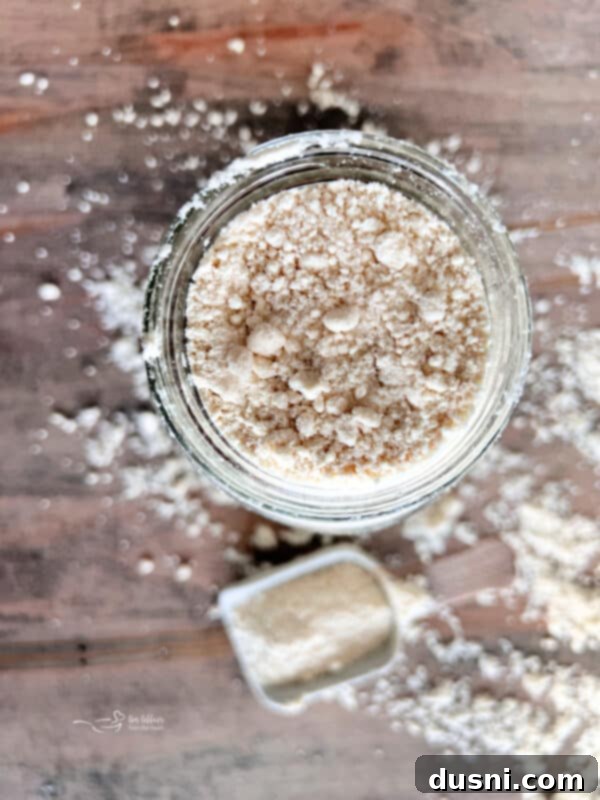
Step 3: Proper Storage
Once your homemade Bisquick mix is thoroughly combined, transfer it to an airtight container. Mason jars are an excellent choice for this, as they provide a good seal and look lovely in the pantry. Store the mix in a cool, dark place, such as your pantry or a cupboard, where it will remain fresh for up to three months. Proper storage is crucial to maintain the leavening power of the baking powder and the quality of the fat.
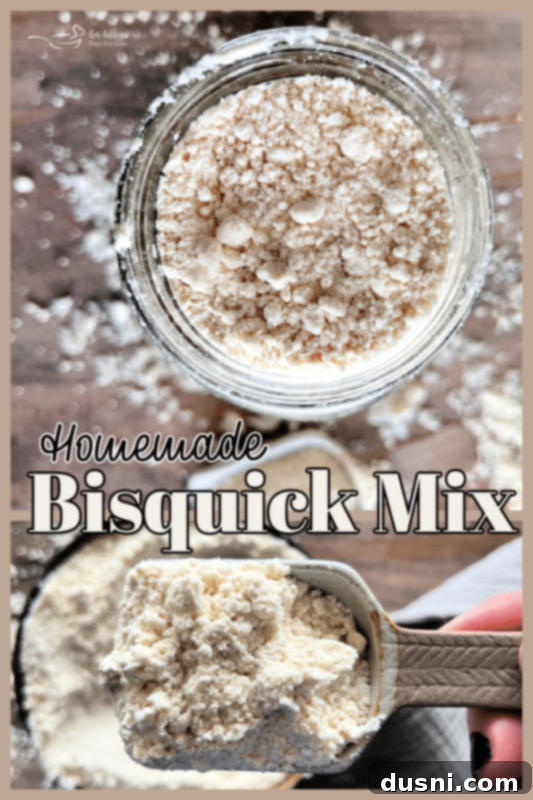
Love It? Pin It!
If you’re excited to try this Homemade Bisquick recipe, make sure to save it for later! Pin it to your favorite Pinterest recipe board so you can easily find it whenever a baking craving strikes!
Frequently Asked Questions (FAQs) About Homemade Bisquick Mix
- How do you make Homemade Bisquick? Homemade Bisquick is remarkably simple to make. It involves combining all-purpose flour, baking powder, a stable fat like vegetable shortening, and a pinch of salt. The key is to cut the fat into the dry ingredients until it’s evenly distributed, creating a crumbly mix.
- What can I use if I don’t have Bisquick? If you’re out of Bisquick, you can use a ready-made pancake mix as a substitute for some recipes, or you can quickly create your own baking mix from scratch using flour, baking powder, shortening or another cold fat, and salt, just like in this recipe. This homemade version is often superior as you control the quality of ingredients.
- Is Bisquick just flour and baking soda? No, Bisquick is not just flour and baking soda. It contains baking powder (which includes both an acid and a base, unlike baking soda alone), shortening (or another fat), and salt, along with flour. Baking soda requires an additional acid in the recipe to activate, while baking powder is a complete leavening agent on its own.
- What are the original ingredients in Bisquick? The original Bisquick recipe, as a commercial product, typically contained bleached white flour, cornstarch, dextrose (a sugar), palm oil (a hydrogenated oil), various leavening agents, canola oil, salt, sugar, DATEM (an emulsifier), and distilled monoglycerides (another emulsifier). The homemade version simplifies this with fewer, more natural ingredients.
- Is Bisquick just flour and baking powder? No, Bisquick is more than just flour and baking powder. For it to function as a versatile baking mix for items like biscuits and pancakes, it also requires a fat (like shortening) and salt. These additional components are essential for texture, flavor, and stability.
What is Shortening and Why is it Ideal for Homemade Bisquick?
Shortening is a broad term for a type of fat that is solid at room temperature. Most commonly, it refers to hydrogenated vegetable oil. The hydrogenation process transforms liquid vegetable oils into a solid or semi-solid form, making them shelf-stable and ideal for baking. Shortening has a high melting point, similar to lard, which prevents it from burning at higher temperatures, unlike butter. This characteristic makes it excellent for creating flaky crusts and tender baked goods.
In the context of homemade Bisquick mix, using vegetable shortening is highly recommended for several reasons. Firstly, its solid form allows it to be easily incorporated into the dry ingredients, creating a stable, powdery mix that doesn’t clump. Secondly, shortening is shelf-stable at room temperature, which means your homemade baking mix can be stored in the pantry for up to three months without refrigeration. This long-term, convenient storage is a major advantage. Furthermore, shortening contributes to a lighter and fluffier texture in baked products like biscuits and pancakes, providing structure without adding excess moisture that liquid oils would.

Versatile Substitutions for Your Baking Mix
One of the greatest advantages of making your own baking mix is the flexibility to customize it. Here are some popular substitutions:
-
Flour Alternatives: Instead of using only all-purpose flour, you can use a combination of flours like spelt or whole wheat for added nutrition and a different flavor profile. For those with gluten sensitivities, you can easily make a gluten-free Bisquick by substituting with your favorite cup-for-cup gluten-free flour blend.
-
Fat Alternatives: While shortening is excellent for stability, you can use other fats. Cold, unsalted butter, cut into small pieces, works beautifully for flavor but requires refrigeration. Lard offers a traditional taste and excellent flakiness. Coconut oil can be used for a vegan option and stores well at room temperature when solid. For a mix intended for immediate use or refrigeration, you could even consider liquid oils like canola, sunflower, or safflower, though these change the texture and storage requirements significantly.
Maximizing Your Homemade Bisquick: Tips & Tricks
-
Mixing Methods: If a stand mixer isn’t available, a food processor is an excellent alternative. Simply pulse all ingredients together until the fat is finely incorporated and the mixture resembles coarse meal. For a more traditional approach, a pastry blender, two forks, or even your clean fingertips can be used to cut the cold fat into the flour. The goal is small, even pieces of fat throughout the flour for optimal flakiness.
-
Sift for Smoothness: For an extra-smooth, lump-free mix, consider sifting your flour and baking powder together before adding the fat. This ensures even distribution of the leavening agent.
-
Accurate Measuring: Always spoon flour into your measuring cup and level it off with a straight edge rather than scooping directly from the bag. This prevents over-packing the flour, which can lead to a dry mix.
-
Freshness Counts: Ensure your baking powder is fresh. Old baking powder will result in flat, dense baked goods. Check the expiration date and perform the fizz test if unsure.
Optimal Storage for Freshness and Longevity
Proper storage is essential to maintain the quality and effectiveness of your homemade baking mix. Different fats require different storage conditions:
-
For Shortening, Coconut Oil, or Lard: When using these stable, solid fats, your homemade baking mix can be stored in an airtight container in a cool, dark place (like your pantry) for up to 3 months. Since it lacks the chemical stabilizers found in commercial mixes, its shelf life is shorter than store-bought options, but still ample for regular use.
-
For Butter: If you choose to use cold butter in your mix, it must be stored in the refrigerator. The dairy content in butter makes it more perishable than shortening. In the fridge, your butter-based mix will remain fresh for about 3 weeks. Always check for any off-odors before use.

Delicious Recipes That Use Bisquick Baking Mix
Now that you have your homemade Bisquick baking mix, what delectable creations will you whip up? This versatile substitute for Bisquick flour can be used in countless recipes. Here are just a few of our favorite ideas to get you started, ranging from sweet breakfast treats to savory dinner solutions:
- Banana Bread Pancakes (pictured above) – A comforting breakfast twist!
- Chocolate Pancakes with Raspberry Sauce – Indulgent and delightful.
- Banana Pecan Rolls – A sweet, gooey treat perfect for brunch.
- Easy Berry Bisquick Muffins – Quick, simple, and packed with fruity flavor.
- Impossible Pie with Bacon & Swiss – A savory, satisfying meal that truly feels “impossible” to make so easily.
- Recipe for Bisquick Peach Cobbler – A classic dessert made effortlessly.
- Pumpkin Spice Bars – Perfect for fall or any time you crave warm spices.
- Copy Cat Red Lobster Cheddar Bay Biscuits – Bring the restaurant favorite home!
- Recipe for Bisquick Sausage Balls – A fantastic appetizer or breakfast bite.
- Sour Cream Bisquick Biscuits – Extra tender and flavorful biscuits.
- Lasagna Pot Pie – An unexpected and delicious dinner idea.
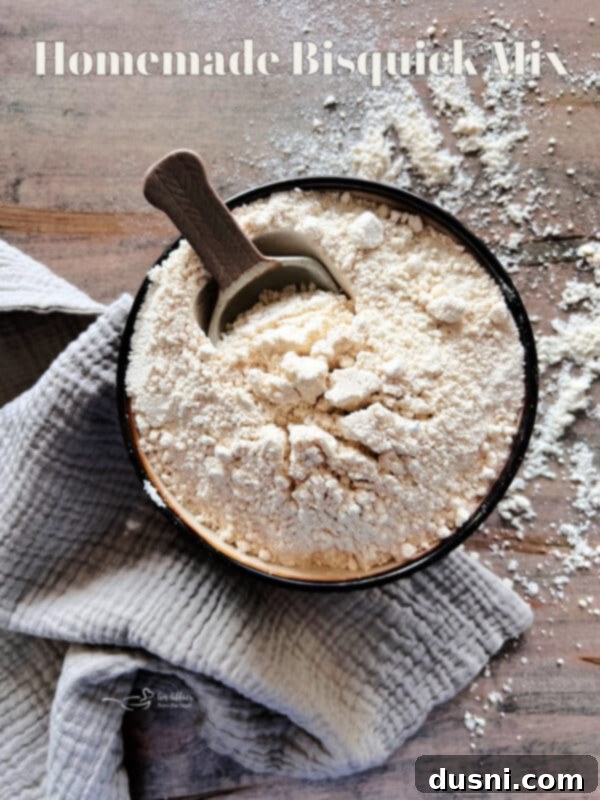
The next time your recipe calls for Bisquick, there’s no need to fret or rush to the store. With this easy recipe, you can make your own high-quality, customizable baking mix at home. Enjoy the convenience, savings, and delicious results!

LIKE THIS RECIPE?
Don’t forget to give it a ⭐️⭐️⭐️⭐️⭐️ star rating and
leave a comment below the recipe!

Print Recipe
Make your own Bisquick
Equipment
-
Mason Jars 32 oz wide mouth
-
Spring Chef Dough Blender, Top Professional Pastry Cutter with Heavy Duty Stainless Steel Blades, Medium Size, Black
-
Kitchenaid Stand Mixer
-
KitchenAid Hand Mixer
Ingredients
- 6 cups flour
- 3 Tablespoons baking powder
- 1 cup vegetable shortening
- 1 Tablespoon salt
Instructions
-
In your standing mixer with the whisk attachment, whisk together flour, baking powder and salt.
-
Add in shortening, in small increments and continue whisking until completely incorporated. A minute or two is all you need.
-
Store in an airtight container, in a cool and dark place for up to 3 months.
Notes
Nutrition
This recipe was originally posted on September 30, 2015. It was updated to improve user experience on April 18, 2023.
